
Original Link: https://www.anandtech.com/show/1624
GeForce Go 6800 Ultra: Powering the Dell Inspirion XPS Gen 2
by Derek Wilson on February 24, 2005 3:04 PM EST- Posted in
- GPUs
Introduction
Back when we first took a look at the NVIDIA GeForce Go 6800 we mentioned that NVIDIA was able to run their part at much higher 450/600 clock speeds (the part we tested was running at 300/300). It was much easier for OEMs to drop graphics solutions into existing designs DTR designs using the Pentium 4 and GDDR1 RAM for the video card. Using the hot Pentium 4, much of the Thermal Design Power (TDP), the limit on how much power can be dissipated as heat, is taken up by things other than the graphics core. DDR1 also runs hotter than DDR3, and thus memory clocks are also limited by the thermal restrictions.Today, Dell is introducing their Inspirion XPS Gen 2. The DTR notebook features a 2 or 2.13GHz Pentium M and a GeForce Go 6800 Ultra with 450/550 core/memory clocks. Rather than just ship their Go 6800 at the high core speed, NVIDIA has given it the Ultra moniker to differentiate the product.
The "new" GeForce Go 6800 Ultra graphics card is exactly the same as the original Go 6800, except that we are finally seeing it at the high clock speeds NVIDIA originally promised we would see. For an explanation of the differences between NVIDIA's mobile and desktop products, please see our initial review.
Aside from simply exchanging the Pentium 4 setup for a Pentium M, Dell has also invested more time in improving its thermal solution. The result is a thinner (it's still not thin), lighter (still feels like a brick) efficiently cooled desktop-in-a-notebook. NVIDIA informed us that the TDP for the chassis is 65W. This is not something we will see anywhere but the DTR segment. Most of the large TDP is taken up by the graphics solution, as Dothan based Pentium M processors and DDR2 system memory run at comfortable temperatures. The new Inspirion XPS Gen 2 is also Alviso based.
This is a fairly significant design win for NVIDIA as Dell's previous XPS graphics solution was ATI's Mobility Radeon 9800.
The Test
Unfortunately, we are somewhat limited in our ability to compare this solution to comparable notebook or desktop systems.We don't have an Alviso based desktop solution (and we haven't seen many Alviso based notebooks yet either). This means we won't be able to compare cards running on the same platform with the Go 6800 Ultra. We also haven't gotten our hands on a Mobility Radeon X800 systems with Alviso in them.
So, what we are going to look at today is the highest end notebook we've yet seen (in terms of graphics speed) compared against the high end desktop configuration we used when testing SLI graphics. This will serve to give us a good picture of where ultra high end notebook performance falls with respect to ultra high end desktop performance. As the core clock on the GeForce Go 6800 Ultra is higher than most desktop GeForce 6800 Ultras (400 to 425 depending on the vendor), it's very possible we could see some interesting numbers come out of this. Of course, the notebook's Pentium M 2.13GHz processor will limit the performance of the system compared to our Athlon 64 4000+ desktop. We aren't likely to see the Go 6800 Ultra paired with anything but a Pentium M due to the TDP requirements of vendors. Mobile Pentium 4 and Mobile Athlon 64 parts are still too hot to be able to economically run a Go 6800 Ultra as well.
The test setup for the Dell Inspirion XPS we tested was as follows:
Intel Pentium M 2.13GHz
Intel Alviso based motherboard
1GB DDR2 533 4-4-4-12
NVIDIA GeForce Go 6800 Ultra (clocked at 450/1100)
Windows XP Service Pack 2 with DirectX 9.0c
NVIDIA ForceWare 75 series Drivers
Our desktop nForce 4 system was configured thusly:
AMD Athlon 64 4000+
ASUS A8N-SLI Deluxe (nForce4 SLI) Motherboard
1GB OCZ DDR400 3-3-3-10
NVIDIA GeForce 6800 Ultra PCI Express (clocked at 400/1100)
NVIDIA GeForce 6800GT PCI Express (clocked at 350/1000)
Windows XP Service Pack 2 with DirectX 9.0c
NVIDIA ForceWare 69.33 Drivers
The only unknown factor here is the performance difference beween the 69.xx and 75.xx ForceWare revisions. The Dell is the only notebook we've tested with a 75 series driver.
Doom 3 Performance
Without AA, the performance of the Go 6800 Ultra falls between the 6800 GT and Ultra. This is very good when comparing a mobile part to desktop parts on a much more powerful computer.Pushing up the settings to include AA drops the performance of the Go 6800 to a level below that of the desktop 6800 GT. Performance is still very competitive, but at higher settings we would expect CPU to be less of a factor. It is possible that the power savings features of the Go are limiting it's ability to scale as well with settings. Unfortunately, we can't make any firm claims on this until we compare the parts in similar platforms.
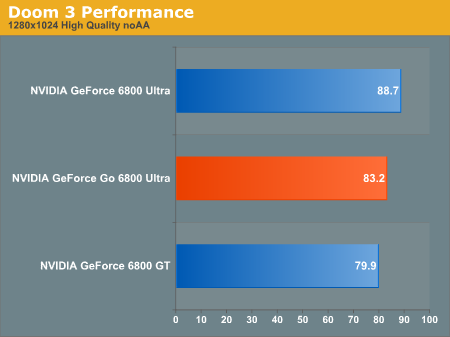
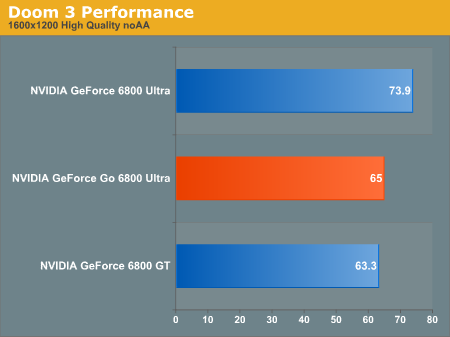
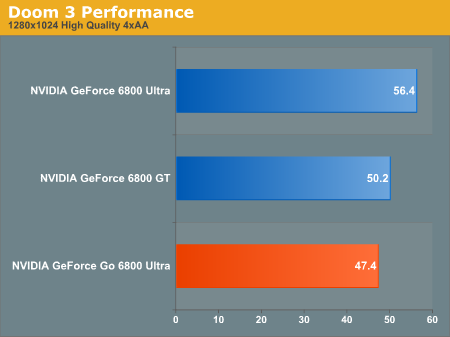
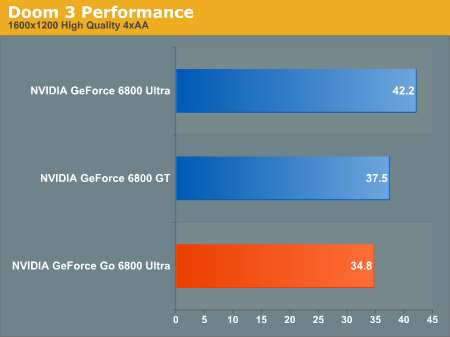
FarCry Performance
The NVIDIA GeForce Go 6800 Ultra in the Dell XPS Gen 2 performs extremely well under FarCry. We used the 1.3 version of the game for tests here, and as we can see the the Go 6800 Ultra either leads in performance or does just as well as it's desktop counterpart.Again, we can see that the desktop parts scale slightly better under AA/AF.
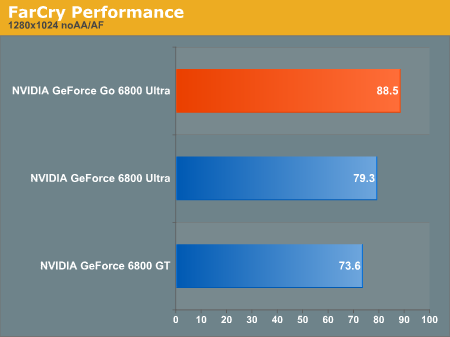
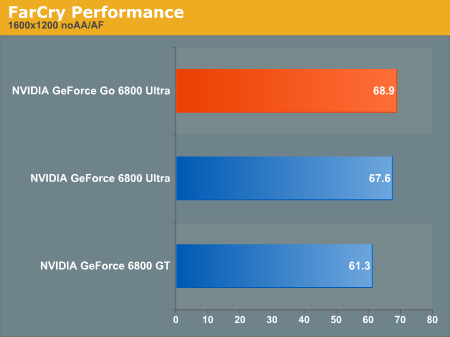
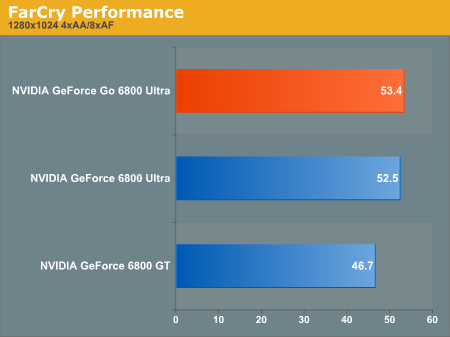
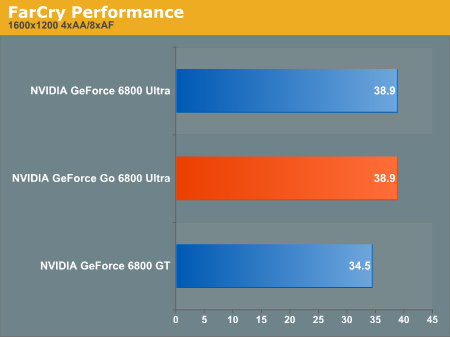
Half-Life 2 Performance
Our Half-Life 2 performance tests were done by taking the average performance across all 5 of our Half-Life 2 benchmarks. The Go 6800 Ultra performs excellently under HL2. Again performance drops compared to the desktop at the highest resolution with AA/AF.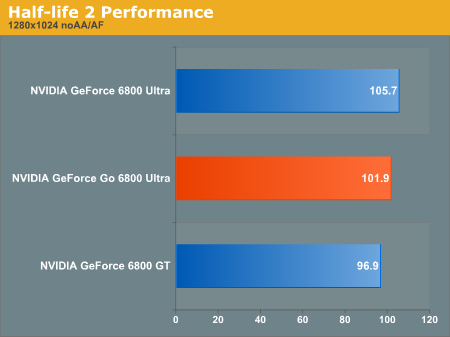
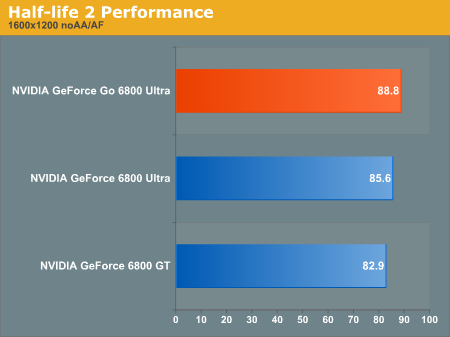
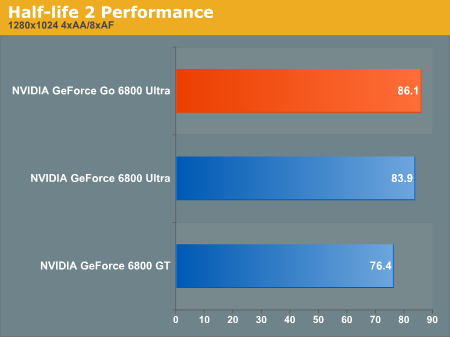
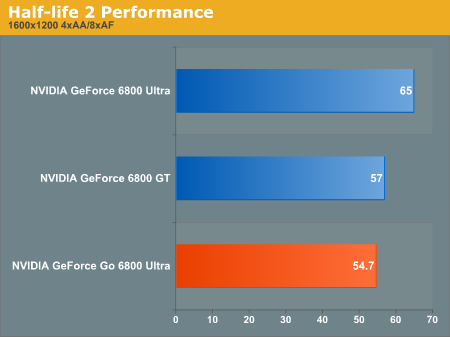
Halo Performance
We only had benchmarks at 1600x1200 here, and the desktop parts seem to perform better here. Of course the Go 6800 is definitely not a poor performer at high res. When we ran 1280x1024 numbers, we saw 70.7 frames per second.Halo also ran well on the XPS at higher resolutions.
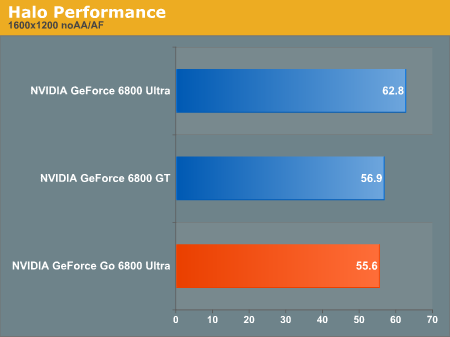
Unreal Tournament 2004
Unfortunately, Unreal is very limited by the 2.13GHz Dothan. Performance without AA/AF was steady at about 57 frames per second. We even saw 57fps at 1920x1200 (the system's native resolution) with no AA/AF. And yes, we triple checked the vsync and UT2004.ini settings.Enabling AA/AF dropped performance only at higher resolutions as well. We even saw playable frame rates at 1920x1200 with AA/AF (about 40 frames per second).
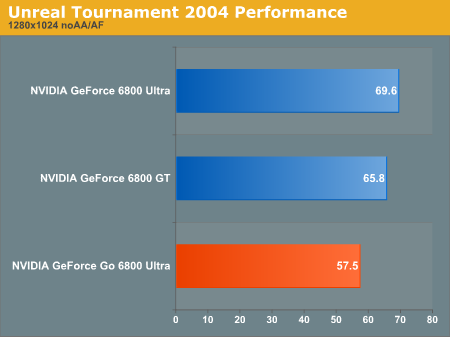
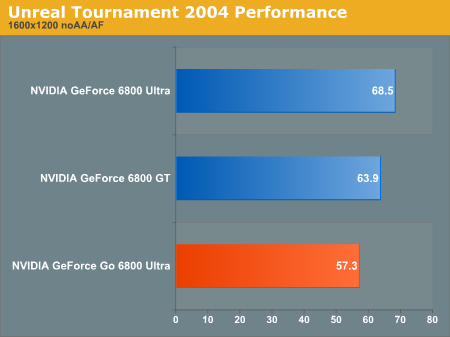
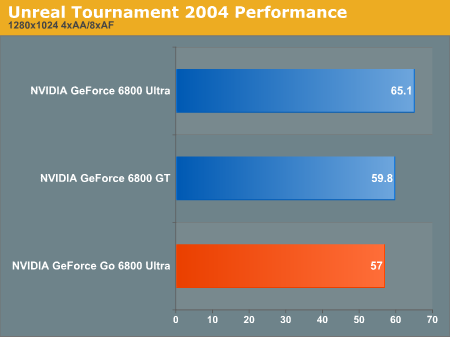
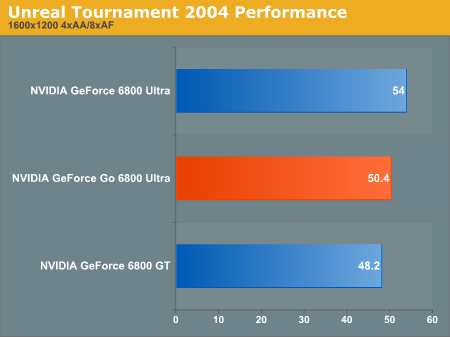
Final Words
The performance of the GeForce Go 6800 Ultra is unprecedented in the mobile space. Of course, while the mobility of a DTR system is always debatable, there's no doubt that scaling down powerful systems to this size has its advantages and appeal (especially when there is no sacrifice in graphics performance).Without having a comparable comparison platform, we can't directly compare the Go 6800 Ultra and the desktop 6800 parts. It does seem clear that Go 6800 Ultra is at least as powerful as its desktop counterpart. Being limited by a less powerful CPU and still coming out on top in more than a couple tests is very impressive.
We would still like to setup a direct comparison between the Go and desktop 6800 parts in order to examine the part on a clock for clock level. We would like to better determine the impact of the power saving features in mobile part. The 50MHz speed bump from the desktop to the Go 6800 Ultra seems only possible due to power saving features. On the desktop NVIDIA tried the 6800 Ultra Extreme, but most vendors were only able to get their parts to about 425 (and this in a virtually thermally unlimited environment). Of course, performance is one of the tradeoffs in the balance, and a clock for clock comparison in the same platform would give us some good data on the GeForce Go line's efficiency compared to the desktop.
It's also useful to note that the new XPS Gen 2 did not get as hot to the touch. It seems Dell has done a better job of getting heat to move outside the system in spite of all the power packed into the chassis. We only had one night with the system, so we were unable to perform an in depth analysis of the system.







